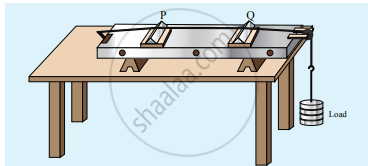Advertisements
Advertisements
Question
What is a sonometer? Give its construction and working. Explain how to determine the frequency of tuning fork using a sonometer.
Solution
Sonometer is used for sound-related measurements. Using this device, The following quantities can be determined.
- The frequency of the tuning fork or frequency of the alternating current.
- The tension in the string.
- The unknown hanging mass.

Sonometer
Construction:
The sonometer is made up of a hollow box which is one meter long with a uniform metallic thin string attached to it. One end of the string is connected to a hook and the other end is connected to a weight hanger through a pulley as shown in Figure 11.34. Since only one string is used, it is also known as monochord. The weights are added to the free end of the wire to increase the tension of the wire. Two adjustable wooden knives are put over the board, and their positions are adjusted to change the vibrating length of the stretched wire.
Working:
A transverse stationary or standing wave is produced and hence, at the knife edges P and Q, nodes are formed. In between the knife edges, anti-nodes are formed. If the length of the vibrating element is then
`l = lambda/2 => lambda = 2l`
Let f be the frequency of the vibrating element, T the tension of in the string and p the mass per unit length of the string. Then using equation, we get
f = `v/lambda = 1/(2l) sqrt("T"/mu)` in Hertz ...(1)
Let ρ be the density of the material of the string and d be the diameter of the string. Then the mass per unit length μ
`mu = "Area" xx "density" = pi"r"^2rho = (pirho"d"^2)/4`
Frequency f = `"v"/lambda = 1/(2l) sqrt("T"/((pi"d"^2rho)/4))`
f = `1/(l"d") sqrt("T"/(pirho))` ....(2)
APPEARS IN
RELATED QUESTIONS
For a particular tube, among six harmonic frequencies below 1000 Hz, only four harmonic frequencies are given: 300 Hz, 600 Hz, 750 Hz and 900 Hz. What are the two other frequencies missing from this list?
Let y = `1/(1 + x^2)` at t = 0 be the amplitude of the wave propagating in the positive x-direction. At t = 2s, the amplitude of the wave propagating becomes y = `1/(1 + (x - 2)^2)`. Assume that the shape of the wave does not
change during propagation. The velocity of the wave is:
What is a stationary wave?
Explain the formation of stationary waves.
Write the characteristics of stationary waves.
Discuss the law of transverse vibrations in stretched strings.
Explain the concepts of fundamental frequency, harmonics and overtones in detail.
A sound wave is transmitted into a tube as shown in the figure. The sound wave splits into two waves at point A which recombine at point B. Let R be the radius of the semi-circle which is varied until the first minimum. Calculate the radius of the semi-circle if the wavelength of the sound is 50.0 m.

Police in a siren car moving with a velocity 20 ms– chases a thief who is moving in a car with a velocity v0 ms-1. The police car sounds at frequency 300 Hz, and both of them move towards a stationary siren of frequency 400 Hz. Calculate the speed in which thief is moving. (Assume the thief does not observe any beat)
